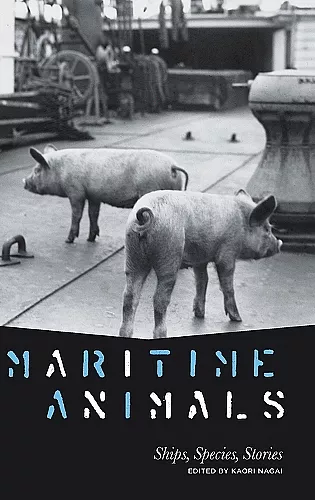Maritime Animals
Ships, Species, Stories
Format:Hardback
Publisher:Pennsylvania State University Press
Published:6th Jun '23
Currently unavailable, and unfortunately no date known when it will be back

A thoughtful, global maritime history that centers non-human animals.
This volume explores nonhuman animals’ involvement with human maritime activities in the age of sail—as well as the myriad multispecies connections formed across different geographical locations knitted together by the long history of global ship movement.
Far from treating the ship as a confined space defined by the sea, Maritime Animals considers the ship’s connections to broader contexts and networks and covers a variety of locations, from the Canadian Arctic to the Pacific Islands. Each chapter focuses on the oceanic experiences of a particular species, from ship vermin, animals transported onboard as food, and animal specimens for scientific study to livestock, companion and working animals, deep-sea animals that find refuge in shipwrecks, and terrestrial animals that hunker down on flotsam and jetsam. Drawing on recent scholarship in animal studies, maritime studies, environmental humanities, and a wide range of other perspectives and storytelling approaches, Maritime Animals challenges an anthropocentric understanding of maritime history. Instead, this volume highlights the ways in which species, through their interaction with the oceans, tell stories and make histories in significant and often surprising ways.
In addition to the editor, the contributors to this volume include Anna Boswell, Nancy Cushing, Lea Edgar, David Haworth, Donna Landry, Derek Lee Nelson, Jimmy Packham, Laurence Publicover, Killian Quigley, Lynette Russell, Adam Sundberg, and Thom van Dooren.
“Maritime Animals provides a readable, highly entertaining, fascinating look at the roles animals and other non-human agents played in the making of the maritime world.”
—J. Rankin Choice
“In a rare feat for edited collections, there is no weak essay among the bunch. Every contribution is both interesting and a delight to read. From animals intentionally brought onto ships to those which came of their own accord, from horse to sponge, this volume offers us a vision of how broad animal studies can be.”
—Dolly Jørgensen H-Environment
“As in every menagerie, this collection of beasty papers truly holds something for everyone; but for the friends of the scaly and slimy, and of the salt-splashed quadrupeds, there is also a delightful whimsy found here even as critter agency is weighed carefully against the asymmetrical influence of the human animal on others’ lives and wellbeing.”
—Sara Rich Journal of Maritime Archaeology
“With each chapter focusing on relationships between humans, ships, and different animal species, Maritime Animals redefines the scope of what we see as maritime into a less anthropocentric conceptualization of ocean-based interactions. Through animal case studies, the authors present the maritime world as a complex ecology of human and nonhuman interactions, mediated through the technologies of ships. This book makes valuable contributions in particular to animal studies, environmental history, ecocriticism, and maritime history.”
—Jakobina Arch, author of Bringing Whales Ashore: Oceans and the Environment of Early Modern Japan
“The ten chapters in Maritime Animals challenge academic norms, be it through the unusual species being written about (snails, worms, reptiles), or via the uncanny theorizations of space and time, as explored from the perspective of nonhuman species. This collection pushes maritime studies into new directions, including a better appreciation of relationships between animals and shipping, history and ecology, pests and colonialism.”
—Andrew Kincaid, author of Postcolonial Dublin: Imperial Legacies and the Built Environment
ISBN: 9780271095370
Dimensions: 229mm x 152mm x 22mm
Weight: 454g
240 pages